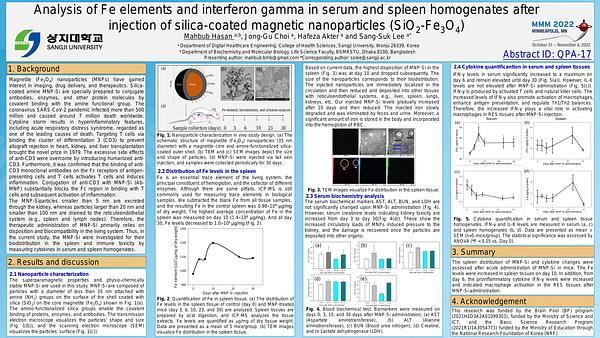Would you like to see your presentation here, made available to a global audience of researchers?
Add your own presentation or have us affordably record your next conference.
This work describes the use of magnetoresistive (MR) sensors coupled with a portable platform for the detection of dengue virus (DENV), a mosquito-borne infection
endemic to low- and middle-income countries, affecting 100-400 million people each year1. Nowadays, diagnosis relies on molecular or serological tests. Still, these tests remain discrete
(RNA vs. antibodies), and tend to be complex and/or expensive, requiring expert staff and fully equipped laboratories. As such, this work aims to combine both assays in a single analysis
by simultaneously detecting DENV RNA and anti-DENV antibodies using a portable platform2,3. A spin-valve based biochip was designed and functionalized with specific DNA oligo
probes and secondary antibodies (Fig1A)4. Extracted RNA and serum samples were provided by INSA-CEVDI and used as targets in molecular and serological assays, respectively. In
both assays, streptavidin coated 250 nm magnetic nanoparticles were used for biolabeling. The measurement output is represented by a voltage drop (dV/V) proportional to the number of
captured target molecules (Fig1B). However, to increase the dynamic range of the assays, the percentage difference of dV/V signals obtained using different immobilization
strategies/probes, was taken as the final output signal. Using the MR-platform, individual tests were carried out for the detection of DENV RNA and anti-dengue human antibodies. The
RNA target was detected down to a few hundreds of pM (Fig2A). For the serological response, a calibration curve with an LOD of 1.38 nM was achieved. Infected patients’ serum was also
tested for anti-DENV antibodies, obtaining a sensitivity of 100% and a specificity of 92%(Fig2B). Finally, simultaneous detection of antibodies and RNA was successfully achieved on the
same chip, showing no differences to the individual assays. To increase the multiplexing capability of the assay, a biochip with 144 sensors and multi-level contact layers was developed
and is under testing using DENV as a model disease. This chip design will allow the simultaneous discrimination of various viruses endemic in the same regions.
References:
1 Who.int. 2022. Dengue and severe dengue. online Available at: https://www.who.int/news-room/fact-sheets/detail/dengue-and-severe-dengue Accessed 14 June 2022.
2 J. Germano et al., Sensors 9, 4119 (2009).
3 V. C. Martins et al., Biosensors and Bioelectronics 24, 2690 (2009).
4 D. C. Albuquerque et al., Biosensors and Bioelectronics 210, 114302 (2022).

